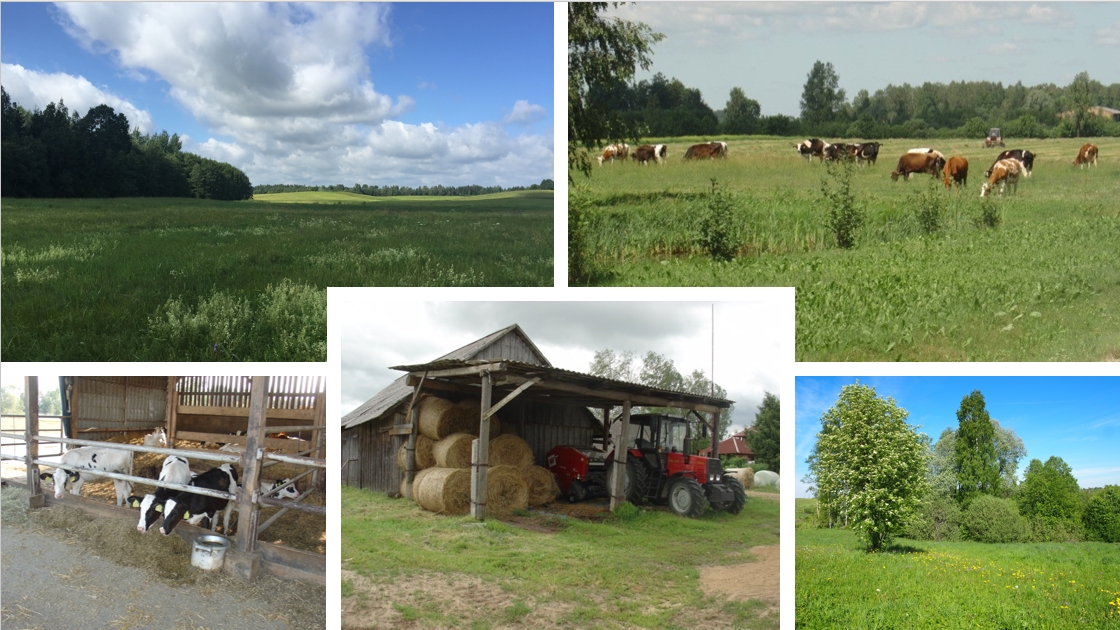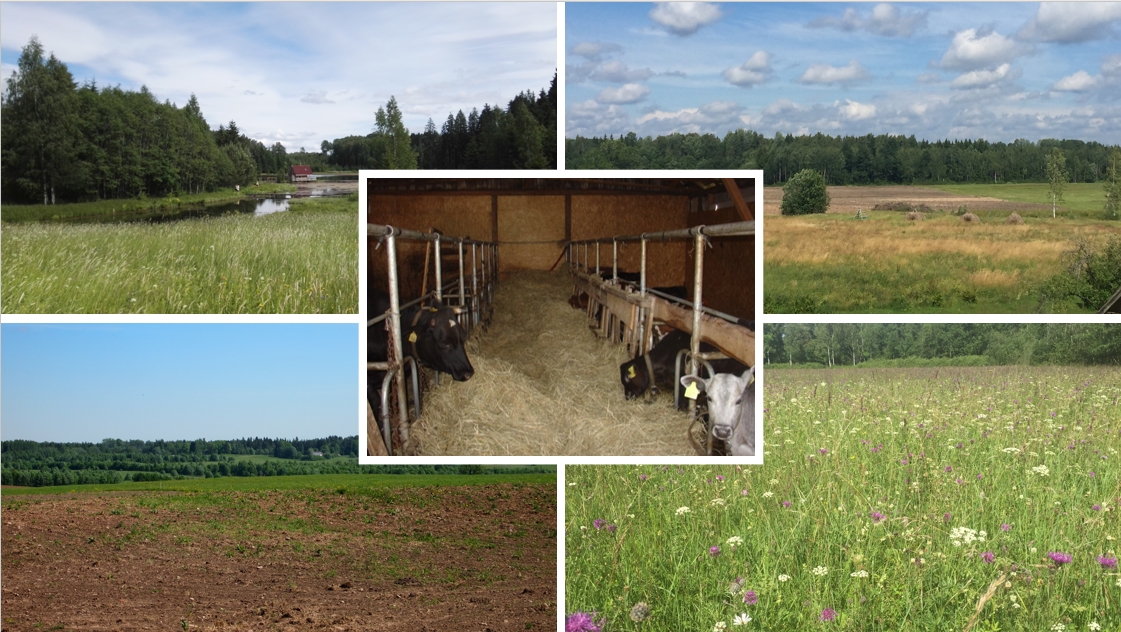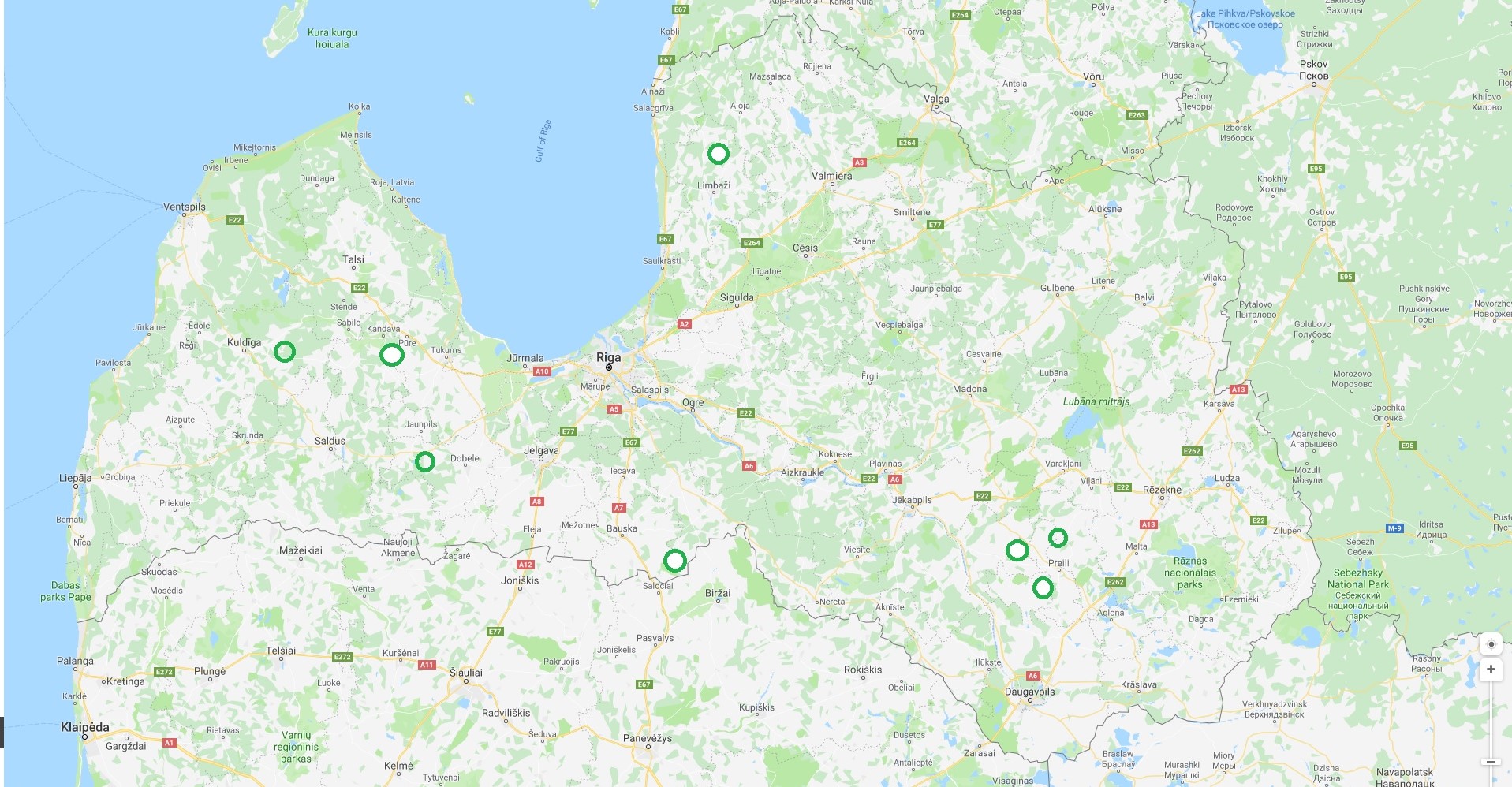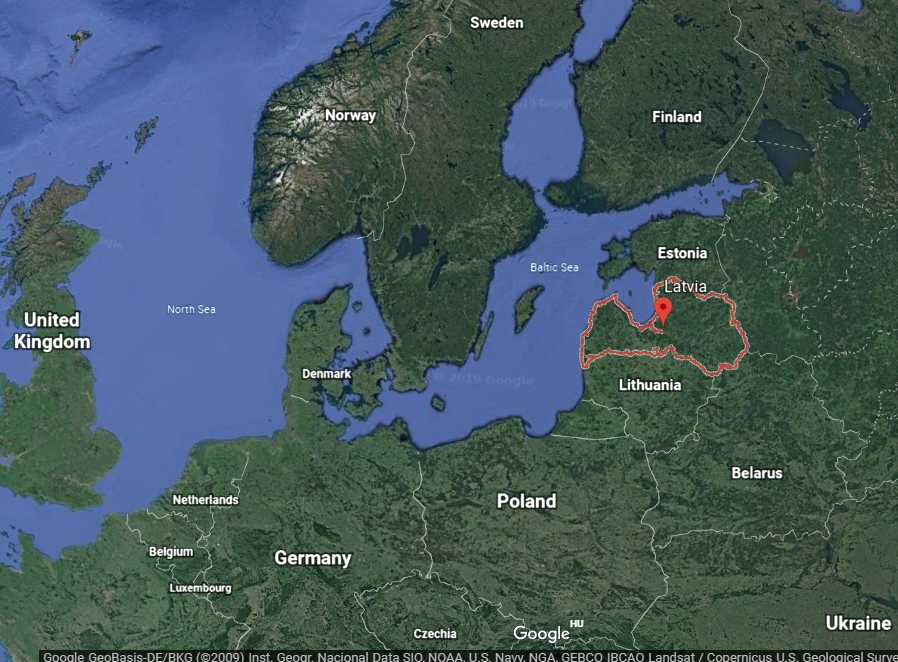CASE STUDY DILEMMAS AND RESEARCH QUESTIONS
The Latvian case study aims to explore transition strategies which address barriers and drivers of the economic viability of conventional and organic, largely grass-based, dairy farms by identifying actions that strengthen organic and agro-ecological farming practices, increasing the amount of certified organic milk processed into organic dairy products and stimulating consumer demand for organic dairy products.
Key Dilemmas
- How to increase the economic viability of conventional and organic, largely grass-based, dairy farms while preserving biodiversity in grasslands and water resource quality?
- How to ensure that all organic milk is processed into organic dairy products?
Research questions
- How to motivate organic farmers to maintain organic/ agro-ecological production?
- How to motivate conventional farmers to transition to agro-ecological production?
- How to raise the efficiency (and competitiveness) of dairy farms? (incl. increasing the cooperation between farmers)?
- How to increase productivity in terms of average milk yield and improve milk quality?
- Which agro-ecological factors have a significant impact on dairy farming?
- How to diversify production and increase innovation in conventional/ organic dairy products for the local and regional market?
- How to stimulate market demand for organic dairy products in the local market?
KEY CHARACTERISTICS AND SUSTAINABILITY ISSUES OF THE FARMING SYSTEM
Key Characteristics of the Dairy Sector
Latvia is well suited to organic dairy farming as large grassland areas are too wet for crop production, but are rich in plant biodiversity for the production of grass-based feedstuff for dairy cattle. There is tradition of “natural” dairy farming based on complex crop rotations without the use of chemical fertilizers and pest control. Economic viability of small organic dairy farms is dependent on on-going EU agricultural support. Dairy farmers have demonstrated a willingness to transition to organic dairy farming practices incentivized by EU agricultural support payments which can amount to 50% of total farm income for organic farms.
Certified organic agricultural land makes up about 14% of all agricultural land. Organic dairy farms (2104) account for 50% of all organic farms (4105) in Latvia, whereas organic dairy farms make up about 10% of all dairy farms and milk production. Conventional and organic dairy farms operate on grassland and arable land. The typical dairy operation is the “family farm” with less than 30 dairy cattle.
Sustainability Challenges to the Organic Dairy Sector
Milk production is 25% lower on organic dairy farms - 5055 kg/cow/year versus 6740kg/cow/year on conventional dairy farms. Production value/ha is about 50% lower on organic dairy farms as compared to conventional dairy farms. On both farm types expenses/ha exceed production value/ha. However, since organic dairy farms receive a larger agricultural support payment, net farm income/ha is about 25% higher on organic dairy farms.
Organic dairy farmers are unable to receive a premium price for their milk due to a weak position in the value chain which is dominated by 50 dairies, 7 of which are organic, and large retail chains. In 2017, less than 50% of the produced organic milk was processed as organic dairy products, while 40% processed as conventional dairy products, due to logistical challenges to organic milk collection, high retail prices and low consumer demand. Over-supply of organic milk in relation to consumer demand results in a low price being paid to farmers, in many cases equivalent to that paid for conventional milk. The economic viability of small dairy farms is dependent on on-going EU agricultural support.
Local product labels (e.g. Green Spoon) with lower environmental quality standards compete with EU and national organic labels, thus negatively impacting on consumer demand for organic dairy products. Even though, presently, the supply of organic milk exceeds demand, there is nevertheless a strong lobby by the Association of Latvian Organic Agriculture to expand organic dairy farming for the sake of farmers’ livelihoods and environmental protection. At the same time there is a growing recognition on the part of consumers of the value of healthy food produced in an environmentally friendly manner.
KEY ACTORS INVOLVED
- Farmers and farmers’ representatives Farmers Parliament; Association of Latvian Organic Agriculture.
- Organic/ Conventional Dairy Producers: Tukuma Piens, Talsu Piens, Lazdonas Piensaimnieks, Cesvaines Piens, Trikatas Piens, Cooperative Viļāni, Preiļu siers.
- Milk Logistics Companies: Rigas Piensaimnieks, Piena Partneris, Talsu Piensaimnieks.
- Ministry of Agriculture and affiliated institutions: Rural Support Service, Food and Veterinary Service; State Plant Protection Agency; Agriculture Data Centre.
- Ministry of Environment and Regional Development and affiliated institutions: State Environmental Service; State Environmental Bureau.
- Organic Farming Certification Bodies.
- Trainers, educators, researchers: Rural Consultation and Training Centre; Agricultural University of Latvia; Institute of Agricultural Resources and Economics.
- Representatives from environmental NGOs: Latvian Fund for Nature, WWF-Latvia.

AGRO-ECOLOGICAL PRACTICES AND SUSTAINABILITY TRADE-OFFS
Agro-ecological Farming Practices of Small Conventional and Organic Dairy Farms
Both small conventional and organic dairy farms typically graze dairy cattle on perennial grassland and produce their own roughage (hay, silage) and grain feed (oats, wheat, barley, rye, buckwheat). Clover is sown in temporary grassland to improve soil fertility and to produce a richer roughage. Legumes, such as peas, are intercropped with grain crops (oats, wheat). Organic dairy farms use only organic fertilizers, whereas conventional dairy farms additionally use mineral fertilizers and chemical plant protection products. Grain yields are typically 50% less in organic operations (2 tonnes/ha).
Transition from conventional to organic dairy farming practices and elimination of mineral fertilizer use results in the following trade-offs and synergies:
Trade-offs
- lower milk production;
- decreased crop yields;
- more grazing and a greater proportion of roughage in the feed mix.
Synergies
- decrease in total CO2eq, kg CO2eq/ha and kg CO2eq/tonne of crop;
- increase in species, habitat and genetic diversity and water and soil quality;
- increase in Net value added, Net farm income and Labour productivity due to CAP subsidies received for organic farming.
KEY BARRIERS OF IMPLEMENTATION AGRO-ECOLOGICAL PRACTICES
Some of the barriers to organic dairy farming are related to the on-farm production of organic milk, whereas others are linked to ensuring delivery of organic milk to organic dairies for processing as organic dairy products. The existing surplus of organic milk highlights the need to stimulate consumption of organic milk or production of milk products with a longer expiration date. Key barriers include:
Supply barriers
- Insufficient support for transition to organic farming practices to compensate for reduced crop and milk yields;
- Lack of differentiation of CAP Pillar II organic farming support payments; based on the complexity of agro-ecological and agri-environmental practices;
- Limited knowledge of agro-ecological practices to maintain soil fertility/ crop yields and for weed and pest control;
- Low level of mechanisation and outdated infrastructure on small organic farms;
- Lack of skilled auxillary dairy workers;
Supply & Demand Barriers
- Small volume of milk production and limited cooperation among organic farmers and dairies;
- Lack of logistic infrastructure to collect certified organic milk from dispersed organic dairy farms for delivery to organic dairies;
- Lack of a national policy on organic farming and food.
Demand Barriers
- Low public procurement of organic products;
- High price of organic dairy products leading to low consumer demand.

KEY ACTIONS AND STRATEGIES TO OVERCOME BARRIERS
Key measures identified to overcome barriers include both farmer-focused supply and consumer-focused demand measures:
Policy Measures Supporting Production
- Provision of a premium support payment to dairy farmers during the transition period to organic farming practices;
- Differentiation of support payments for the maintenance of organic farming practices depending on the degree of their complexity (e.g. introducing N-fixing crops in the crop rotation, intercropping, landscape measures to promote biodiversity and water quantity/ quality management);
- Provision of preferential farm modernization investment support to small and medium size dairy farms;
- Increased financial support for the training of advisory services specialists and farmers on organic, agro-ecological farming practices;
- Increased coordination between the Ministries of Agriculture and Welfare and the Rural Consultation and Education Centre to develop a farm auxillary worker training programme.
Policy Measures Supporting Production & Consumption
- Increased financial support for cooperation among organic dairy farmers and with organic dairies to increase processing of organic dairy products and to improve the position of farmers in the value chain;
- Higher state support payment to organic dairy farmers for organic milk processed as organic dairy products.
- Adoption of a national Organic Farming and Food Policy.
Policy Measures Supporting Consumption
- Adoption of mandatory public procurement criteria for organic dairy products;
- Lowering of the Value Added Tax on organic dairy products from 21% to 5%.
KEY LESSONS LEARNT
- Transition from conventional to organic dairy farming practices reduces milk and crop yields, but results in improvements in environmental performance, including decreased total CO2eq emissions, increased biodiversity and habitats and improved water and soil quality.
- EU CAP and national support instruments have proven effective in incentivizing farmers to transition from conventional to organic dairy farming practices by compensating for decreased milk production and farm income.
- The growth and acceptance of organic farming and food by EU farmers and consumers makes organic farming a good point of departure for a transition to more sustainable farming and food systems such as agro-ecology.
- Receipt of support payments for the maintenance of organic dairy practices in accordance with the EC Organic Regulation produces dependence on subsidies and does not incentivize farmers to improve their economic viability and environmental performance.
- EU CAP and national policy instruments should only provide financial incentives to transitioned organic dairy farms differentiated according to the complexity of agro-ecological farming practices and the performance of agri-environmental-climate measures.
- Policies supporting transition to organic dairy and agro-ecological farming practices should be based on comprehensive, integrated and long-term approaches that address both supply and demand.
- Policies incentivizing the adoption of organic, agro-ecological farming practices and agri-environmental-climate measures should also integrate the provision of tailored advice, training and experience exchange for farmers.
- Consumer-focused demand for organic dairy products can be stimulated by the adoption of mandatory public procurement criteria and by lowering the Value Added Tax rate for organic dairy products.
- As the adoption of organic and agro-ecological farming practices is a long-term practice-based learning process, transition is likely more viable for younger farmers, farms undergoing a generation change, farmers with knowledge of traditional farming practices and farmers open to innovation.
Download
- UNIISECO H2020 Issue brief_Strengthening Agro-Ecological Farming Practices and Economic Viability of Organic Dairy Farms in Latvia
- UNISECO H2020 Issue brief_Stiprinot agro-ekoloģiskās prakses un bioloģiskās piena lopkopības ekonomisko ilgtspēju Latvijā
- UNISECO H2020 policy brief: Differentiation of support for organic farming based on the complexity of agro-ecological farming practices and performance of agro-environmental measures in Latvia
- UNISECO H2020 policy brief: Policies Enabling Transition to Organic Dairy Farming Systems in Latvia
- UNISECO H2020 Policy brief: Atbalsta pasākumu diferencēšana bioloģiskajai lauksaimniecībai Latvijā
- UNISECO H2020 Policy brief: Politikas atbalsts pārejai uz bioloģiskās piena lopkopības sistēmu Latvijā
References
- Agroresursu un ekonomikas institūts, 2019. Ziņojums Lauku attīstības programma 2014-2020 LAP 2014-2020 atbalsta ietekme uz bioloģiskās lauksaimniecības attīstību.
- Central Statistical Bureau of Latvia, 2018a. AGRICULTURE OF LATVIA Collection of Statistics.
- Central Statistical Bureau of Latvia, 2018b. FARM STRUCTURE IN LATVIA 2016. Collection of Statistics
Related newsitems
- https://uniseco-project.eu/news/140/research-article-assessing-agro-ecological-practices-using-a-combination-of-three-sustainability-assessment-tools
- https://uniseco-project.eu/news/125/lv-case-study-multi-criteria-assessment-of-transition-strategy-policy-instruments
- https://uniseco-project.eu/news/99/lv-case-study-roundtable-discussion-on-strengthening-the-transition-to-grass-based-organic-dairy-farming-in-latvia

Dairy Farming in Latvia
